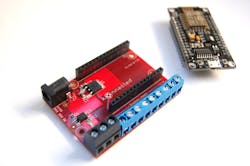Konnected Alarm Panel turns wired security systems into smart home solutions
It seems as if every week a new do-it-yourself security system or smart home device is hitting the market. From cameras and intelligent locks to motion detectors and thermostats, there’s hardly a piece of security or home automation hardware installed in residential properties today that’s not wirelessly connected to the internet. But what about all of that existing wired infrastructure that still exists in many homes today from the security systems of old? Couldn’t it serve a purpose in the smart homes of today?
That’s exactly what Nate Clark thought when he bought a Samsung SmartThings hub last year and wanted to incorporate the pre-wired security system in the home he was renting into it. However, much to his surprise, there wasn’t any way to accomplish this with products currently available on the market, so Clark, a software developer by trade, started “tinkering” and thus the development of what would become the Konnected Alarm Panel began.
“This started out as a hobby project for me, not necessarily something I wanted to invent and start a business but it has sort of pulled me in that direction,” Clark explains. “Initially, I found these Internet of Things Wi-Fi chips that I’m using now for the product and I programmed them and that was a fun experience. This was my first little foray into hardware engineering but these newer Wi-Fi IoT chips make it really easy to program for someone with just a software background, so I initially wrote an application for these chips and then put it up on GitHub, shared it on the SmartThings community forum and it turned out there had been a lot of people who were looking for solutions like this.”
Based on this feedback, Clark developed and sold over 500 pre-packaged DIY kits to customers across the globe. He’s now looking to expand on this initial success and has launched a campaign on the popular crowdfunding website Kickstarter. Those who contribute to the Kickstarter campaign will have the option to buy the panel in configurations of six-, 12-, 18- and 24-zone setups for $69, $99, $129 and $159 respectively.
The panel itself is also easy for consumers to install. Those who purchase the kits will essentially replace the old alarm system panel insider their homes with the new Konnected Alarm Panel by following a few steps.
“Depending on who installed your system – sometimes they do a good of labeling the wires and sometimes not – so you have to first label the different wires so you know which ones go to which doors and which one goes to your siren, etc., and then disconnect them from the old panel, remove it from the wall and connect the wires directly to the new Konnected Alarm Panel,” he says. “There are screw terminals for each of the zones and they are labeled to tell you where the siren, power and all of that stuff goes. You then insert the Wi-Fi chip and use the SmartThings app to configure it.”
Those using the Konnected Alarm Panel will initially be required to have a SmartThings Hub, however; Clark says he is working with smart home hub makers to make it compatible with other systems, such as Wink and HomeAssistant. Clark says he was first attracted to the SmartThings Hub due to its level of openness.
“It’s a fairly open ecosystem. They actively encourage third-party developers to build applications and add-ons to SmartThings and not all platforms are like that,” he says. “They also have a big community (of users) but most importantly, it has a built-in app called Smart Home Monitor which, in my opinion, is a very good implementation of a smart home security system app and it works with any window or motion sensors that you can buy – not just the SmartThings-branded ones but there are dozens if not hundreds of Z-Wave-type sensors… and Smart Home Monitor works with any of those.”
In the future, Clarks says he could envision selling the panel bundled with the SmartThings Hub or other types of smart home systems they integrate with. Clark plans to use the funds raised on Kickstarter primarily to start production of the custom circuit boards he designed, as well as perhaps hire a few contractors to with aid software integrations for some of these other smart home hubs.
While users of the panel will obviously be able to monitor their security systems themselves, there is also a 24/7 professional monitoring option for those who desire it via Scout Alarm, which is offered to SmartThings customers via the aforementioned Smart Home Monitor app.
After embarking on this journey to develop a product that would integrated wired alarm sensors into today’s wireless smart home systems, Clarks says many people have expressed disbelief over the fact that there hasn’t been a similar solution on the market until now.
“There’s definitely a need in this market because there are wired security systems in millions of homes - in the U.S. and Canada - and there is no product out there that lets you really take ownership of those systems,” he says. “In reality, these alarm system sensors are very simple technologies, just a circuit that’s open or closed, so it doesn’t really take anything proprietary to be able to detect that the sensor is open or closed and it was fairly straightforward for me to build something.”
The Kickstarter campaign, which was launched on Tuesday, has already surpassed its $25,000 goal with over $31,000 being raised as of this writing. For more information, click here.
About the Author:
Joel Griffin is the Editor-in-Chief of SecurityInfoWatch.com and a veteran security journalist. You can reach him at [email protected].



